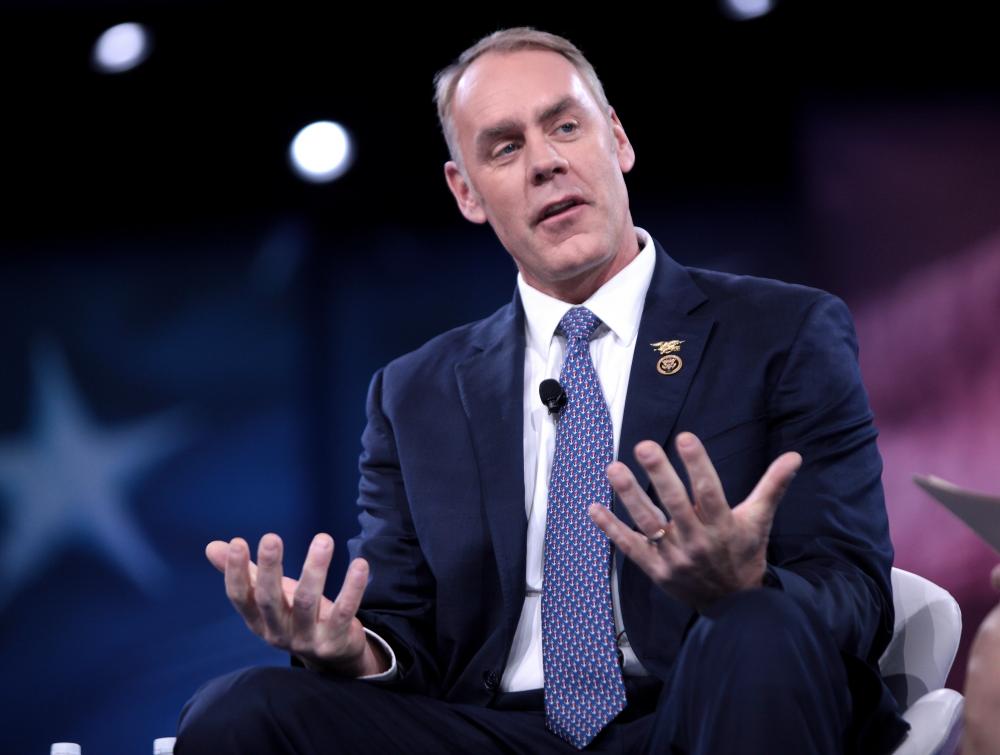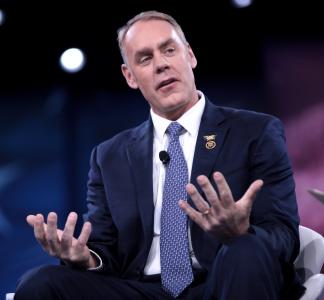Zinke, Year One: 14 misdeeds that show why he's the worst Interior secretary ever

Interior Secretary Ryan Zinke
Gage Skidmore, flickr
14 bad things
Even by the Mariana-Trench-low standards of the Trump administration, Interior Secretary Ryan Zinke has been a remarkably destructive cabinet member, moving the nation backwards on public lands issues and energy while damaging the internal culture of the agency entrusted to him. As with his boss, we're ready to call it: Zinke is the worst Interior secretary ever.
We work every day to keep abreast of what Zinke and his allies are doing—and counter them, when possible—but even we find it impossible to catalogue every single bad thing he has done. So we're choosing 14 of those bad things, in no particular order, to give a sense of the range and depth of his attacks on public lands since starting the job on March 1, 2017.
1) Carving up Bears Ears and other national monument lands
If Zinke's time at the Department of the Interior is remembered for any single action, it will likely be his recommendation that President Trump drastically cut both Bears Ears National Monument and Grand Staircase-Escalante National Monument in Utah. When Trump acted on it, using proclamations that were likely illegal (we're challenging him in court), he executed the single largest rollback of land protections in American history. Shortly after, Zinke recommended reduced protections for national monument lands in Oregon and Nevada, along with potentially damaging management changes in Maine, New Mexico and the Atlantic and Pacific oceans.
2) Paving the way to drill America's last truly wild place
As a prelude to Congress' passage of a White House-blessed tax bill that invites oil and gas drilling in the sensitive coastal plain of the Arctic National Wildlife Refuge, Zinke pushed for seismic testing to determine whether there was oil in that landscape--one of the last great, intact wild ecosystems on the planet. It left no doubt that the Trump administration and other anti-conservation lawmakers were working together to undermine the crown jewel of our National Wildlife Refuge System in the name of dangerous oil and gas development.
3) Weakening protection for sage-grouse
In 2015, federal agencies teamed with local and state interests to craft a plan that protected western sagebrush habitat, a rugged but fragile home to some 350 wildlife species (notably the greater sage-grouse, an iconic American bird whose population has been cut in half over the last 40 years, and whose health is considered a key indicator of the health of the entire ecosystem). That plan was the product of nearly a decade of work by interests ranging from ranchers to state wildlife agencies, but it took Zinke only a few months to effectively dismantle it, yet again privileging the short-term needs of oil, gas and mining companies who want more land open for development. As explained by Nada Culver, senior director of agency policy and planning at The Wilderness Society, Zinke's move is "a sideways attempt to abandon habitat protection for unfettered oil and gas development[.]"
4) Pushing dirty coal mining on public lands and nationwide
Among President Obama's biggest energy achievements was declaring a moratorium on new coal mining on public lands, a move that decreased production of climate change-driving fossil fuels and protected lands and waters. Zinke reversed the moratorium within a month of taking office as part of the Trump administration's effort to unravel Obama-era advances on environmental protection. Interior also short-circuited an overdue review of the nation’s federal coal program, preserving an outdated system that lets coal companies buy up leases for well below market value without giving taxpayers a fair share for the resources they own.
5) Encouraging ocean drilling off the Arctic, Atlantic and Pacific coasts
A decision released early in 2018 would allow offshore drilling for oil and gas in virtually all of America’s coastal waters, including the Arctic, Atlantic and Pacific oceans, as well as allowing oil companies access to new offshore leases off California for the first time in decades. This move poses a grave threat to thousands of miles of sensitive shorelines that are home to indigenous communities, marine mammals, shorebirds and fishing and tourism-dependent businesses (imagine another Deepwater Horizon oil spill, this time off the coast of Seattle or Los Angeles). Interior Secretary Ryan Zinke’s plan puts energy first on billions of acres of federal waters by erasing a safer five-year program that was developed under the Obama administration to prohibit new leasing in the Arctic and sensitive areas of the Atlantic, eastern Gulf of Mexico and Pacific.
6) Reversing rules that limit methane pollution
One lowlight of the Zinke Interior Department's campaign to reverse environmental protections was the Bureau of Land Management's proposal to gut a rule that protects communities from methane pollution created by oil and gas drilling on public lands. The original “methane rule” would reduce methane emissions from drilling projects by 35%, addressing what is considered a "blind spot" in U.S. efforts to tally and curb greenhouse gas emissions. Now, the Bureau of Land Management wants to eliminate several protection and safety requirements, making it easier for oil and gas companies to waste our natural resources and pollute our air.
7) Jacking up national park entrance fees
Under Zinke, Interior wants to raise entrance fees at 17 national parks, even as the Trump administration continues to starve public land agencies. The fee increases would take about 173 years to address the national parks' deferred maintenance backlog, a stated reason for the change, but will inarguably rob some families of the opportunity to visit. Not long after that news, the administration also decided to eliminate six of the fee-free days it offers for all national parks. So much for Zinke's confirmation-hearing platitudes about motivating more Americans to experience the outdoors.
8) Making the California desert an unbalanced energy development zone
Under Zinke, the Department of the Interior is trying to allow more development, mining, grazing and off-road vehicle use on huge swaths of land in the California desert by gutting a rule called the Desert Renewable Energy Conservation Plan. That plan, based on eight years of scientific analysis, protected the most sensitive areas--including habitat for animals like desert tortoise and bighorn sheep--while helping to expedite responsible clean energy projects in others. Revising it is just another move that throws careful research and balanced planning out the window in the name of boundless development.
9) Toxic mining next to America's most popular wilderness area?
At the end of 2017, in classic 'news dump' fashion, Zinke's Interior Department quietly issued a decision encouraging mining next to Minnesota’s Boundary Waters Canoe Area Wilderness, which has been called the most-visited wilderness area in America. The project they are moving forward could end up discharging sulfuric acid, sulfates and heavy metals (some of which are highly toxic) into water, harming fish and wildlife—and possibly even contaminate lakes and rivers within the wilderness area itself. A few weeks later, Interior announced they would do a less thorough study than previously planned on how that mining would affect the Boundary Waters. It's one of the worst examples of Zinke and co fast-tracking activity that could irreparably harm a truly indispensable American landscape.
10) Precedent-shifting move to force a road through Alaska wilderness
The vast majority of Alaska's Izembek National Wildlife Refuge has been designated as a federal wilderness area for decades, meaning it is an unusually pristine piece of land protected from development and other damaging activity. That didn't stop Zinke's Interior Department from executing a "land swap" with a private company that is considered the first step to building a road through the refuge. The move could endanger numerous migratory birds, brown bears and caribou while threatening to close off access to sportsmen. Further, it could serve as a model for future challenges to federal wilderness protection, America's highest standard of public land conservation for over 50 years.
11) Cozying up to the "land takeover" fringe
Zinke was once an outspoken critic of the "public land takeover" movement, which seeks to take national public lands out of the protective care of agencies like the National Park Service and U.S. Forest Service so that they can be taken over by state governments—potentially leading to these places being sold off to oil, mining and logging companies. But soon after being sworn in, he attended a prominent pro-land takeover group's annual meeting. Shortly thereafter, the Interior department tacitly supported land sell-offs by offering positive testimony for a bill that would push to sell off 6,000 acres of public land in Arizona. If his first year is any indication, Zinke will grow closer still to the proponents of land seizure—and they will keep on inching from the fringes to the mainstream of American politics, with dire consequences for the institution of public lands.
12) An assault on transparency
In February 2018, two senior U.S. Geological Survey officials resigned after they said Zinke pressured them to violate the office's scientific integrity policy by sharing data before it was released to the public. But this was only the latest in a long line of episodes in which Zinke shirked transparency or tried to cut the American people out of decision-making. Not long before the staffers quit, media reported the Bureau of Land Management was trying to introduce obstacles to filing Freedom of Information Act requests, one of several steps taken to reduce public input. And in the highest profile example, Zinke recommended the Bears Ears and Grand Staircase-Escalante cuts without ever explaining how he made his decision (it must not have involved consideration of the public comments he solicited, which ended up decisively opposed to his monument review).
13) Agency roiled by staff upheaval and palace intrigue
Zinke has taken a variety of actions to "re-organize" or "streamline" the Department of the Interior that have actually served to sow confusion and undermine its core conservation purpose. Among these are an attempt to reshuffle and relocate the agency's offices, which has drawn criticism from a bipartisan group of governors, and re-assigning or demoting staffers who don't back Zinke's agenda. Zinke has also failed to fill key agency positions, leaving the National Park Service and U.S. Fish & Wildlife Service without directors, and declined to meet with Interior's long-running National Park Advisory Board—he was purportedly reevaluating whether the group was necessary--prompting 10 of 12 members to resign in frustration. More recently, many members of the dozens of public lands advisory boards that work with Interior complained that they are being shut out of key management discussions since Zinke took over. Beyond staffing chaos, Zinke seems to be installing a bizarre culture that values loyalty to him and Trump over the agency's mission (how many people do you know who fly a personal flag when they're in the office for the day?).
14) Toeing the Trump climate denial line
In addition to troubling cultural and staffing shifts mentioned above, Zinke's Interior Department has evidently suppressed climate scientists who won't toe the Trump administration line; omitted climate change from its strategic planning documents; erased climate change material from agency handbooks; and even cracked down on staff trying to talk about climate change (the secretary himself reportedly chewed out a Joshua Tree National Park employee for tweeting about the subject). Zinke once broadly acknowledged climate change was a real problem, but that appears to be ancient history.



